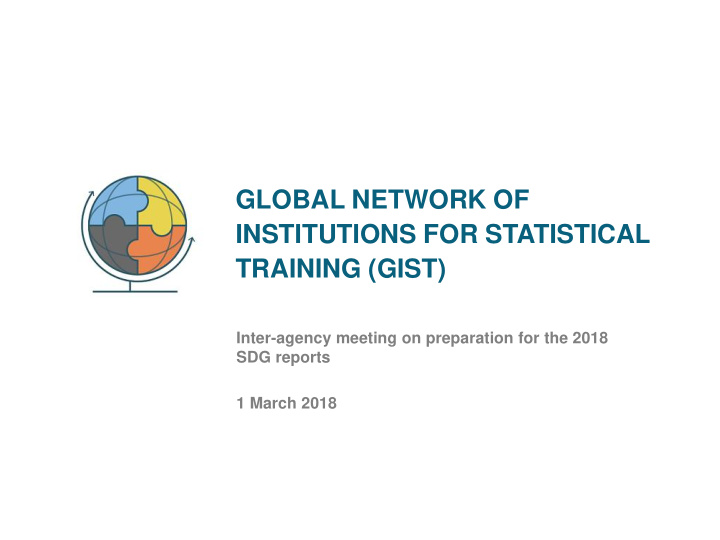



GLOBAL NETWORK OF INSTITUTIONS FOR STATISTICAL TRAINING (GIST) Inter-agency meeting on preparation for the 2018 SDG reports 1 March 2018
Background and Context 2030 Agenda has led to an unprecedented demand for data and statistical capacity building: training is a key pillar in strengthening statistical capacities. A wide variety of approaches in how global and regional institutions deliver training Coordinated and harmonized approach that can make training delivery more efficient and effective . Benefits envisioned from a global network of training institutions (number of countries) Alignment with international standards 17 Avoidance of duplication and optimization of 16 resources Improved outreach 13 Harmonized curricula 9 Others 6 Source: Seminar on statistical training, Beijing, 13-15 September 2017 Global Network of Institutions for Statistical Training (GIST)
Global Network of Institutions for Statistical Training (GIST) Establishment after consultations with various stakeholders 1 2 3 4 5 Beijing Approval from Country Establishment of First meeting in Conference, NSOs and the GIST March 2018 consultations, September 2017 training and training institutions needs assessments Goal To build sustainable capacities in countries through efficient, effective and harmonized delivery of statistical training at global and regional levels Global Network of Institutions for Statistical Training (GIST)
Structure of the GIST Founding member • 15 members, includes international and regional training institutions representing all regions of the world • Countries whose NSOs provide training outside their countries Secretariat Advisory group • 11 countries proposed • United Nations Statistics Division representing all regions. GIST (UNSD) is the Secretariat of the GIST • Group provides guidance on various matters, for example: programme implementation Chair • Group to be finalized in March • Chosen from the Founding Members • Rotated every two years Global Network of Institutions for Statistical Training (GIST)
Founding Member Institutions Membership is expanding to include national training institutions Regional and International Training Providers PARIS 21 12. International Monetary Fund (IMF) UN Economic Commission for Africa (ECA) 1. 13. World Bank International Statistical Institution (ISI) 2. 14. International Labour Organization (ILO) United Nations Statistics Division (UNSD) 3. 15. United Nations Statistical Institute for Asia and 4. the Pacific (UNSIAP) National Institutions (as of February 2018) Eurostat 5. Secretariat of the Pacific Community (SPC) Brazil 6. 1. Eastern Africa Statistical Training India 7. 2. Centre (EASTC) Ecole Nationale Superieure de Statistique et d' 8. Economie (ENSEA) Arab Institute for Training and Research in 9. Statistics (AITRS) Statistical, Economic and Social research and 10. Training Centre for Islamic Countries (SESRIC) United Nations Institute for Training and 11. Research (UNITAR) Global Network of Institutions for Statistical Training (GIST)
Anticipated work areas of the GIST Work streams would be finalized at the first meeting on 8 March Needs assessment and addressing training gaps Share training courses, calendars and other materials Harmonize training courses in line with international guidelines and standards Develop and nurture pool of trainers in different statistical areas Foster global discussion on certification Leverage capacity for distance learning Global Network of Institutions for Statistical Training (GIST)
GIST website will play a key role Website will be a central location for accessing training calendars, curricula, course materials etc., as information becomes available. Detailed institutional profiles in terms of training arrangements of existing members are already available for download https://unstats.un.org/GIST Global Network of Institutions for Statistical Training (GIST)
Recommend
More recommend